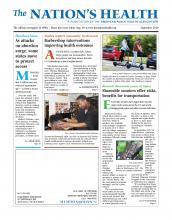Electric scooters have zipped their way into major metro areas across the U.S. and world, bringing both praise and safety concerns with them.
Shared e-scooters, which allow riders to rent the devices in one place and leave them in another, are available from multiple companies in dozens of U.S. cities and on college campuses. According to the National Association of City Transportation Officials, nearly 40 million trips were taken on shared e-scooters in 2018.

People ride electric scooters in Herne, Germany, in June. While the scooters are growing in popularity, many users tend not to use helmets or follow other safety rules, leading to injuries.
Photo by Roland Weihrauch, courtesy Picture Alliance/Getty Images
“Shared micromobility has the opportunity to be a game-changer for those without the means, ability or desire to maintain a private vehicle,” Nicole Payne, MS, the association’s program manager, said in a news release.
The e-scooters have been hailed as an easy, environmentally friendly way to get around. But their spread has not come without growing pains — or actual physical pain in the form of injuries. Since fall 2017, at least 1,500 injuries and eight deaths in the U.S. have been linked to the devices, according to Consumer Reports.
In September 2017 in Santa Monica, California, ride-share scooters from Bird became available in the city. It was not long before clinicians started seeing traumatic injuries related to the devices, said Tarak Trivedi, MD, an emergency physician and scholar in the National Clinician Scholars Program at the University of California-Los Angeles.
“It’s exciting how these scooters are changing how people get around, but on the other side of the coin, you can expect people to get injured as they move around at 15 miles per hour,” Trivedi told The Nation’s Health.
UCLA researchers tracked scooter-related emergency room visits from September 2017 through August 2018, documenting 249 cases. Published in February in JAMA Network Open, their research found that broken bones and head injuries made up a majority of scooter injuries, accounting for over 70% of emergency room visits. There were several serious head injuries that particularly concerned researchers.
“Most people who got injured using these scooters didn’t really seem to know what they were signing up for,” said Trivedi, lead author of the study. “They just didn’t imagine they could get hurt so badly.”
The study found that, by and large, injured riders were not wearing helmets and that other regulations, such as restrictions on rider age, were not followed.

Though e-scooters are readily available in many cities and easy to rent, many riders are unaware of dangers.
Photo by Aaron Warnick
Similar results were found in a study released in April that examined hundreds of e-scooter injuries that were sustained in Austin, Texas. Researchers from Austin Public Health and the Centers for Disease Control and Prevention collaborated on the study, finding there were at least 20 injuries per 100,000 rides.
Researchers surveyed riders who visited emergency rooms, finding that only one of the 190 respondents was wearing a helmet at the time of their injury. Almost half of people who were hurt sustained a head injury. Other related factors included excessive speed, alcohol consumption within 12 hours of riding and using a mobile device while operating a scooter.

E-scooters offer safety tips for riders, such as wearing helmets, but riders often ignore them, risking injuries. Since fall 2017, at least 1,500 injuries and eight deaths in the U.S. have been linked to the devices, according to Consumer Reports.
Photo by Aaron Warnick
“Our findings show the risks involved in riding scooters and have significant implications in considering what individual safety measures can help reduce injury,” Stephanie Hayden, MSW, director of Austin Public Health, said in a news release.
As the popularity of e-scooters continues to climb, new riders may continue to find themselves in the emergency room. According to the Austin research, one-third of injuries occur on a rider’s first time on an e-scooter. Over 60% of injuries occur within the first 10 rides.
Protected lanes for e-scooter riders, such as those already in use in many cities for bicyclists, could help keep users safe from collisions with cars. Research from the Journal of Transport & Health published in June found that separate paths and bike lanes result in safer cities overall, not just for riders.
“There’s a direct relation between how we use our public space and public health,” Colin Browne, communications director at Washington Area Bicycle Association, told The Nation’s Health. “We can’t ignore that connection and the way our infrastructure affects the choices that people make about how they get around.”
But e-scooter riders are not the only ones at risk from the devices. The UCLA study found that 8% of emergency room visits related to scooter injuries came from non-riders who were either struck by a scooter or tripped over a parked device.
Because e-scooters can be left anywhere at the end of a ride, the devices have been criticized for blocking both sidewalks and accessibility ramps.
Heidi Simon, deputy director of AmericaWalks, says decisionmakers need to consider pedestrians when they are making policies about transportation options and safety.

A group of scooters waits for riders in Washington, D.C. The devices are common downtown.
Photo by Aaron Warnick
“Everyone should be able to get around by whatever mode of transportation that they choose, but they shouldn’t infringe on the rights of those who choose to walk,” Simon told The Nation’s Health.
For more information on the Austin-CDC e-scooter study, visit www.austintexas.gov.
- Copyright The Nation’s Health, American Public Health Association









